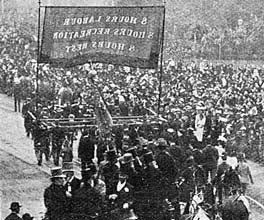Origins of the 8-hour day
In the 1800s, most Victorians worked up to 14 hours a day, six days a week. There was no sick leave, no holiday leave, and employers could sack employees at any time, without giving a reason.
In the 1850s, Victoria was flooded with migrants, all hoping to strike it rich on the goldfields. Many of these were British tradesmen, such as James Stephens, who had been involved with the workers' movement in England. They brought with them a determination to achieve fairer working conditions, including reduced working hours.
There were three main arguments for a reduced working day in Victoria. The first was that Australia's harsh climate necessitated shorter working hours:
...the period of labor under the relaxing influence of an Australian climate, cannot extend to the length of daily toil ruling in the mother country [Britain], without sacrificing health, and shortening the duration of human life.
– Victorian Operative Masons' Society report 11 June, 1884
Victorian Operative Masons' Society, 1912, Report of the committee, Labor Call Print, Melbourne, Vic.
The second was that working men needed time to develop their minds through education:
The self-cultivation...of the ‘adult man'...can only be the work of time. It would be a great advantage then to give the worker time to read and study, and to progress in knowledge and virtue.
– Victorian Operative Masons' Society report 11 June, 1884
Victorian Operative Masons' Society, 1912, Report of the committee, Labor Call Print, Melbourne, Vic.
Up until the late 19th century, children often started work before finishing primary school. The workers' movement believed education was crucial to improving living standards for working-class people and petitioned for every child's right to education.
The third was that tradesmen could become better husbands, fathers and citizens if they were granted leisure time:
The man whose mind is unclogged by the action and influence of severe bodily work, when in health will have his natural flow of animal spirits and kindred sympathies, inclining him to self respect, and respect for other, for law, order, and forms so essential to freedom, domestic virtues and good citizenship.
– Victorian Operative Masons' Society report 11 June, 1884
Victorian Operative Masons' Society, 1912, Report of the committee, Labor Call Print, Melbourne, Vic.
With this in mind, the Builders' Union began its fight for shorter working hours.
In 1856, the stonemasons won the right to a 48-hour working week, which entitled them to Saturday afternoons off. While this doesn't sound like much today, it made a big difference to working class families in the 1850s. It was a pivotal point in Victoria's political history and paved the way for other industries to fight for the same rights in the workplace.











